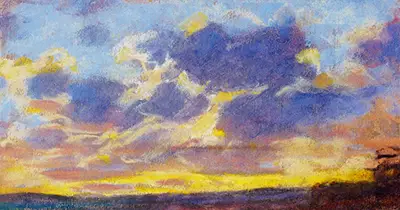This painting is notable for its colourful, billowing clouds and the amazing sense of light that it emits. However, it is also notable because of the medium that Monet used to create the painting.
Unlike his other works, which tended to be created using oil on canvas, this work of art has been executed using pastels on a grey paper. The overall result is something softer than Monet's usual works - as he is best known for his style of applying oil paint directly to the canvas without mixing it to create a very rich and vivid colour scheme.
His choice of pastels to complete this work definitely makes sense, though, as they help to capture the wispy, airy nature of the clouds. Blending colours together rather than overlaying them as he does with his oil on canvas works, also helps to imbue this art work with a unique style.
Nightfall can be viewed in the Musées des Beaux-Arts in Nantes, France. It measures 21.2 cm by 37.9 cm and so it is a relatively small work. Monet completed this work of art at some point between 1865 and 1870 and so it was created in the middle period of his career - an experimental period for him. Monet lived between 1840 and 1926 and he began by painting works that were pretty realist in nature.
Then, he gradually moved on to a more impressionistic style, painting art works in situ (or en plein air as the Impressionists referred to it) to capture the quality of light with a real immediacy. He then became known as one of the foremost figures in the Impressionist movement - indeed for many people the name 'Claude Monet' is synonymous with Impressionism itself. Nightfall is a very characteristically Impressionist piece as it features a natural landscape and places great emphasis on the quality of the light.
As has already been mentioned, many of Monet's paintings were created by him standing outside in situ with his easel and capturing a particular fleeting moment with his artist's materials. The pastel creation, Nightfall, is not different from this: here, Monet is immortalising a very fleeting, momentary glimpse of the way that the light looked and the clouds were moving at a particular time of day.
In many ways, the Impressionists' works can thus be compare to photography - they use their materials to take a 'snapshot' of a natural event for us to cherish forever more. However, they also do more than a photograph does, by conveying the impressions that this moment gives them, and creating a dramatic sense of emotion in the way in which colour is applied to the canvas or the paper.


